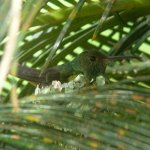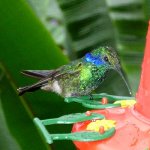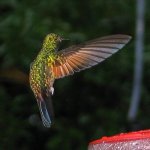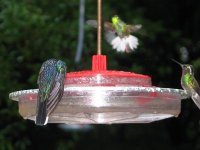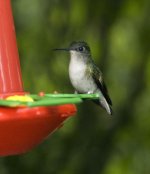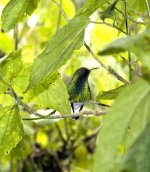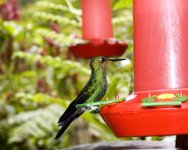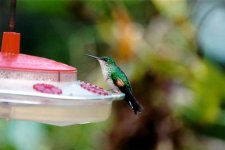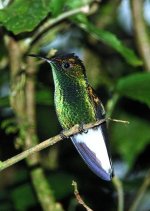-
Welcome to BirdForum, the internet's largest birding community with thousands of members from all over the world. The forums are dedicated to wild birds, birding, binoculars and equipment and all that goes with it.
Please register for an account to take part in the discussions in the forum, post your pictures in the gallery and more.
You are using an out of date browser. It may not display this or other websites correctly.
You should upgrade or use an alternative browser.
You should upgrade or use an alternative browser.
Hummingbird Quiz (6 Viewers)
- Thread starter madamcoolpix
- Start date
More options
Who Replied?madamcoolpix
a.k.a. Madam Butterfly
In photos 1 and 3 you could present 5 possible identifications for each one, and we would choose one as the correct ... What do you say? We call it here 'multiple choice test'..
Luiz, this is going to look like a real exam if I follow your suggestion!!!
Linda, the first one have too long bill for a Volcano HB. As for the postocular eye patch... it is not properly an eye patch, is more a stripe that in this particular pic looks "cut", and it is an important feature.
Here you have the test:
#1 is a female of:
a) Fiery-throated Hummingbird (Panterpe insignis)
b) Long-billed starthoat (Heliomaster longirostris)
c) Magnificent Hummingbird (Eugenes fulgens)
d) Green-fronted Lancebill (Doryfera ludoviciae)
d) Green-crowned Brilliant (Heliodoxa jacula)
#3 is a male of:
a) Red-footed Plumeteleer (Chalybura urochrysia)
b) Stripe-tailed Hummingbird (Eupherusa eximia)
c) Black-bellied Hummingbird (Eupherusa nigriventris)
d) Fiery-throated Hummingbird (Panterpe insignis)
e) Green-breated Mango (Anthracothorax prevostii)
I hope this helps! Happy guessing again!
Hello Marian, and friends!
I'll be the first one to give the answers. For number one, I'll say it is a she Fiery-throated HB. Looking at the size of the bill, it does not seem so big as of the options 'b' and 'd'. For me it does not look like the option 'c', either. So, almost by elimination, I give this answer. Is this a valid method, Marian?
As for the number three, I will say it is a Green-breasted Mango, the reasons are the feathers colors and the size and form of the bill. Also here I have eliminated option 'a' as the bird seems to have black feet, not red; I eliminated option 'b' also, for the bird does not have the white feathers on the internal part of the tail; option 'c' as for me this is a totally different bird; and between options 'd' and 'e' I stay with 'e'.
Cheers everybody!
Luiz
I'll be the first one to give the answers. For number one, I'll say it is a she Fiery-throated HB. Looking at the size of the bill, it does not seem so big as of the options 'b' and 'd'. For me it does not look like the option 'c', either. So, almost by elimination, I give this answer. Is this a valid method, Marian?
As for the number three, I will say it is a Green-breasted Mango, the reasons are the feathers colors and the size and form of the bill. Also here I have eliminated option 'a' as the bird seems to have black feet, not red; I eliminated option 'b' also, for the bird does not have the white feathers on the internal part of the tail; option 'c' as for me this is a totally different bird; and between options 'd' and 'e' I stay with 'e'.
Cheers everybody!
Luiz
Last edited:

Yea! Now I know why my students love M/C quizzes and tests!
#1 Fiery-throated Hummingbird based mainly on nothing else fitting. Mangoverde nor google searches showed a female Fiery-throated. However, Long-billed Starthroat bill didn't look good, Magnificent's bill didn't fit, neither did the Green-fronted, and the Green-crowned Brilliant didn't show the eye patch and had some white on the end of the feathers.
#3 a is out because it's not red-footed, b is out because of the billk, it's not black enough for c, colors don't match for d, which leaves e:
Green-breasted Mango has a curved bill, blue on it's chest, some rufous on side and tale.
And you say they will get tougher!
#1 Fiery-throated Hummingbird based mainly on nothing else fitting. Mangoverde nor google searches showed a female Fiery-throated. However, Long-billed Starthroat bill didn't look good, Magnificent's bill didn't fit, neither did the Green-fronted, and the Green-crowned Brilliant didn't show the eye patch and had some white on the end of the feathers.
#3 a is out because it's not red-footed, b is out because of the billk, it's not black enough for c, colors don't match for d, which leaves e:
Green-breasted Mango has a curved bill, blue on it's chest, some rufous on side and tale.
And you say they will get tougher!
madamcoolpix
a.k.a. Madam Butterfly
Hi, everyone! :hi:
Here I am again, and I must admit you've worked hard with this last test! :clap: :clap: :clap:
Of course, it is valid!!! It is a very convenient way of getting the right answer. I use it for general difficult IDs: I use a checklist of the place where the bird was seen (that is the multiple choice test) and then I start to eliminate options in a reasoned way. It works usually...
And you both have eliminated options very well in general. Let's see:
#3, was easier, and you got it. Your reasons to get to Green-breasted Mango were just perfect. Nothing else to be added.
#1, I must admit this is difficult for me too. You didn't find a female Fiery-throated Hummingbird because both sexes are very alike... so it can't be that one because of the light coloured underparts in my pic. Lancebills and Starthroats have much longer bills than #1 (you were right), so both are ruled out. And I think it is obvious it is not a Green-crowned Brilliant. So, it is, by elimination, again the Magnificent Hummingbird.
I think I have somewhere a pic of Fiery-throated and Magnificent HB together in a feeder. If I find it I will share it here. It may be good for compare both.
I'm posting another set of pics. As I'm leaving for my Easter Holidays I will not have my pictures available (although I will be able to visit the Forum regularly), so this set will be the homework for the holidays. In the last pic there are three species, and I would like you to guess the 3 of them. The first one is that I told you in the nest... I hope I'm not doing anything wrong, I don't want to be told off (I hope not, I've already explained the circumstances...)
In the last pic there are three species, and I would like you to guess the 3 of them. The first one is that I told you in the nest... I hope I'm not doing anything wrong, I don't want to be told off (I hope not, I've already explained the circumstances...)
I will keep an eye on here, and if you have problems I will post again a multiple answers test.
Happy guesses, enjoy yourselves!
Here I am again, and I must admit you've worked hard with this last test! :clap: :clap: :clap:
So, almost by elimination, I give this answer. Is this a valid method, Marian?
Of course, it is valid!!! It is a very convenient way of getting the right answer. I use it for general difficult IDs: I use a checklist of the place where the bird was seen (that is the multiple choice test) and then I start to eliminate options in a reasoned way. It works usually...
And you both have eliminated options very well in general. Let's see:
#3, was easier, and you got it. Your reasons to get to Green-breasted Mango were just perfect. Nothing else to be added.
#1, I must admit this is difficult for me too. You didn't find a female Fiery-throated Hummingbird because both sexes are very alike... so it can't be that one because of the light coloured underparts in my pic. Lancebills and Starthroats have much longer bills than #1 (you were right), so both are ruled out. And I think it is obvious it is not a Green-crowned Brilliant. So, it is, by elimination, again the Magnificent Hummingbird.
I think I have somewhere a pic of Fiery-throated and Magnificent HB together in a feeder. If I find it I will share it here. It may be good for compare both.
I'm posting another set of pics. As I'm leaving for my Easter Holidays I will not have my pictures available (although I will be able to visit the Forum regularly), so this set will be the homework for the holidays.
I will keep an eye on here, and if you have problems I will post again a multiple answers test.
Happy guesses, enjoy yourselves!
Attachments
Last edited:
Hello Marian and friends!
Well, I think I can give an answer to the second and the third birds. I'd say the second one is the green-violet ear ( Colibri Thalassinus ), male, and the third is the Purple-throated mountain gem, (Lampornis calolaema), male. As for the other two, I'm not able to answer..
Cheers everybody!
Well, I think I can give an answer to the second and the third birds. I'd say the second one is the green-violet ear ( Colibri Thalassinus ), male, and the third is the Purple-throated mountain gem, (Lampornis calolaema), male. As for the other two, I'm not able to answer..
Cheers everybody!
Marian: Are you saying that the bird on the nest is the same bird that is on the feeder but we cannot see the head?
I agree with Luis that No. 2 is a green violet-ear. But I've been very confused by the bird on the feeder since it's wings are so much shorter than the tail. I have a suspect, but if the head is as the bird on the nest, then it's not right.
I'm still working on the others.
And I've found a bunch of photos I took at La Paz that I'm trying to identify. So be prepared for another few questions.
Linda
www.chesapeakeimages.com
I agree with Luis that No. 2 is a green violet-ear. But I've been very confused by the bird on the feeder since it's wings are so much shorter than the tail. I have a suspect, but if the head is as the bird on the nest, then it's not right.
I'm still working on the others.
And I've found a bunch of photos I took at La Paz that I'm trying to identify. So be prepared for another few questions.
Linda
www.chesapeakeimages.com
madamcoolpix
a.k.a. Madam Butterfly
Sorry, Linda. I'm affraid my explanation turned out to be a bit confusing. No, the first bird is something and the "headless" bird in the feather is a different one. In total, you have 6 species to guess... but a long time for guessing.
Anyway, as Luiz and Linda agree on #2, I'm confirming it is a Green Violetear. We will see what happens with the others.
Luiz, have you seen the Hummer Lisa posted for you in the Gallery? It is a very pretty picture, you must not miss it!
I would love to help if it was possible. Can you post them here? So I can play the quiz myself!
Cheers!
Anyway, as Luiz and Linda agree on #2, I'm confirming it is a Green Violetear. We will see what happens with the others.
Luiz, have you seen the Hummer Lisa posted for you in the Gallery? It is a very pretty picture, you must not miss it!
And I've found a bunch of photos I took at La Paz that I'm trying to identify. So be prepared for another few questions.
I would love to help if it was possible. Can you post them here? So I can play the quiz myself!
Cheers!
Marian, thank you very much, I had a day away from my computer, and had not seen the lovely picture Lisa has posted in the Gallery till I read your warning! Now I have already seen it, I felt very happy looking at the bill of the she-hummer exactly on the center of the flower! Isn't it a lovely image?
Cheers,
Luiz
Cheers,
Luiz
I'm going to make a try on the 4th picture.
The "headless" bird is, I think, a violet sabrewing female. I say this because of the wings since they are shorter than the tail with a bit of white in the tail. My pictures of the magnificents seem to have wings going out to the end of the tail.
The white-tailed bird is a coppery headed emerald due to the bit of copper color on the top of the head.
The bird on the right is a male purple throated mountain gem.
Linda
I'm working up the pictures I've got and will post them soon. We're fairly busy this week and I may not have time for a few days.
The "headless" bird is, I think, a violet sabrewing female. I say this because of the wings since they are shorter than the tail with a bit of white in the tail. My pictures of the magnificents seem to have wings going out to the end of the tail.
The white-tailed bird is a coppery headed emerald due to the bit of copper color on the top of the head.
The bird on the right is a male purple throated mountain gem.
Linda
I'm working up the pictures I've got and will post them soon. We're fairly busy this week and I may not have time for a few days.
madamcoolpix
a.k.a. Madam Butterfly
Hi, dear ones!
Here I am with a few answers and explanation after you've done your homework.
#1 remains unknown
#2 Green Violetear as already stated.
#3 remains unknown
#4
a) the headless bird is the Violet Sabrewing, but male, not female. The size, wings and tail features point in that direction even without showing the head. And the bluish body is seen too in spite of the light (it was the flash fault!)
b) the flying one is the Coppery-headed Emerald: tiny, very white undertail and the coppery cap with emerald body. Looks a bit odd in the pic as it is out of focus (I was focusing the Sabrewing and that "intruder" showed up in the pic... very welcome!) but the features are all there.
c) cut, but still seen the striking face of the Purple-throated Mountain-Gem: purple throat and long white line behind the eye.
Linda, you've got them all in the last one! Very good!
Luiz, you mentioned the Purple-throated Mountain-Gem but I wasn't sure if you were talking on the 3rd pic or the 3rd bird in the last pic. If is was the later, you were right too.
For #1 (very tricky, I admit that) and #3, here it goes a multiple choice test:
#1
a) Stripe-tailed Hummingbird (Eupherusa eximia)
b) Rufous-tailed Hummingbird (Amazilia tzacalt)
c) Green-crowned Brilliant (Heliodoxa jacula)
d) Green-breated Mango (Anthracothorax prevostii)
e) Coppery-headed Emerald (Elvira cupreiceps)
#3
a) Black-bellied Hummingbird (Eupherusa nigriventris)
b) Brown Violetear (Colibri delphinae)
c) Violet-crowned Woodnymph (Thalurania colombica)
d) Stripe-tailed Hummingbird (Eupherusa eximia)
e) Green-crowned Brilliant (Heliodoxa jacula)
Looking forward to seeing your pics, Linda! But don't rush, we are all quite busy these days. Probably I will not give the answers to these 2 birds until Sunday. So you all are plenty of time to guess.
Have a great week and Easter Time!
Here I am with a few answers and explanation after you've done your homework.
#1 remains unknown
#2 Green Violetear as already stated.
#3 remains unknown
#4
a) the headless bird is the Violet Sabrewing, but male, not female. The size, wings and tail features point in that direction even without showing the head. And the bluish body is seen too in spite of the light (it was the flash fault!)
b) the flying one is the Coppery-headed Emerald: tiny, very white undertail and the coppery cap with emerald body. Looks a bit odd in the pic as it is out of focus (I was focusing the Sabrewing and that "intruder" showed up in the pic... very welcome!) but the features are all there.
c) cut, but still seen the striking face of the Purple-throated Mountain-Gem: purple throat and long white line behind the eye.
Linda, you've got them all in the last one! Very good!
Luiz, you mentioned the Purple-throated Mountain-Gem but I wasn't sure if you were talking on the 3rd pic or the 3rd bird in the last pic. If is was the later, you were right too.
For #1 (very tricky, I admit that) and #3, here it goes a multiple choice test:
#1
a) Stripe-tailed Hummingbird (Eupherusa eximia)
b) Rufous-tailed Hummingbird (Amazilia tzacalt)
c) Green-crowned Brilliant (Heliodoxa jacula)
d) Green-breated Mango (Anthracothorax prevostii)
e) Coppery-headed Emerald (Elvira cupreiceps)
#3
a) Black-bellied Hummingbird (Eupherusa nigriventris)
b) Brown Violetear (Colibri delphinae)
c) Violet-crowned Woodnymph (Thalurania colombica)
d) Stripe-tailed Hummingbird (Eupherusa eximia)
e) Green-crowned Brilliant (Heliodoxa jacula)
I'm working up the pictures I've got and will post them soon. We're fairly busy this week and I may not have time for a few days.
Looking forward to seeing your pics, Linda! But don't rush, we are all quite busy these days. Probably I will not give the answers to these 2 birds until Sunday. So you all are plenty of time to guess.
Have a great week and Easter Time!
Hello, Marian and friends!
I'll venture to give my answers.
For me, number 1 is Rufous-tailed HB, Amazilia tzacalt. The bill in your picture seems to be red, as red is the bill of rufous-tailed, and the other features also seem to be of this hummer.
Number 3 I would say is the Brown Violetear for the back feathers of the other four hummers are green, and not brownish green as the one in Marian's photo.
Marian, when I said last week that the 4th hummer was the purple-throated mountain gem it only could be the one that had a purple throat, that is, the last one, seeing left to right.
Hope I've passed on the exams..
Cheers,
Luiz
I'll venture to give my answers.
For me, number 1 is Rufous-tailed HB, Amazilia tzacalt. The bill in your picture seems to be red, as red is the bill of rufous-tailed, and the other features also seem to be of this hummer.
Number 3 I would say is the Brown Violetear for the back feathers of the other four hummers are green, and not brownish green as the one in Marian's photo.
Marian, when I said last week that the 4th hummer was the purple-throated mountain gem it only could be the one that had a purple throat, that is, the last one, seeing left to right.
Hope I've passed on the exams..
Cheers,
Luiz
Last edited:
Marian: I agree with Luis on the identification of #1 and 3. The only female I could see that didn't have white on the throat was the rufous tailed. So it must be that along with that bit of light color which must be red on the bill.
I had earlier thought about the brown violet ear for the third bird, but just wasn't sure.
Now a few for Marian! I've got a few pictures from the LaPaz Waterfall park that I'm trying to identify. I need some confirmation on these so I'll pose them for the group.
Thanks in advance for your help.
Linda
I had earlier thought about the brown violet ear for the third bird, but just wasn't sure.
Now a few for Marian! I've got a few pictures from the LaPaz Waterfall park that I'm trying to identify. I need some confirmation on these so I'll pose them for the group.
Thanks in advance for your help.
Linda
Attachments
madamcoolpix
a.k.a. Madam Butterfly
Hi, everybody! :hi:
Here I am again! Nice to find you’ve “worked” well during these days! Answers and mystery Hummers to guess, how exciting!!!
Answers and mystery Hummers to guess, how exciting!!!
About my unknown Hummers, #1 is CORRECT!!! :t: It is a female Rufous-tailed Hummingbird, and your deductions very well done.
#3 is not a Brown Violet-ear. I don’t see clearly your reasons for saying that. I think its body looks too greenish for a Brown Violetear. On the contrary, there is something in this bird almost diagnostic. I’m reluctant to say what the bird is; it is not so difficult! The diagnostic feature is that brownish patch in the wings. Can you tell now its name?
As for the quiz… hmmm, very interesting! These are my guesses:
#1 female Black-bellied Hummingbird (Eupherusa nigriventris). I have no pictures of this female in my archives so I am not completely sure about this ID but by elimination using my books it should be this one. First I thought it was a female Coppery-headed Emerald but I ruled that out because the neck sides should be green, not whitish; and her bill is much curved than in this pic. But then I realized this bird has brownish secondaries, pointing an Eupherusa one. The very white undertail matches well, and the straighter bill too. The white neck sides would indicate the Black-bellied instead the Stripe-tailed Hummingbird (Eupherusa eximia); besides, the wing patch is faint in the lady-Black-bellied H (as in the pic), much brighter in the Stripe-tailed… And to make the thing complete, I found out Black-bellied Hummingbird is fairly common in La Paz Waterfalls Gardens. I’ve been in La Paz, I know those feeders and I think this bird is small but not as tiny as the Coppery-headed Emerald.
I wonder if you agree or not, Linda.
#2 male Coppery-headed Emerald (Elvira cupreiceps). That strong pattern of green breast and white underparts is typical only in the CHE and the Stripe-tailed Hummingbird. The shinning plumage can be very confusing and had me doubtful for a long time. But finally I vote for the CHE as the bill seems to be too short and too curved for a STH. The size (as for #1) should help too.
#3 young male Green-crowned Brilliant (Helidoxa jacula). This is the only one I have no doubts. This is a bit tricky because it is not illustrated in the Field Guide of Costa Rican Birds, but once you know it, to misID it is impossible. The rufous chin is diagnostic, and the characteristic profile and shape of the GCB are there.
Looking forward to hearing your opinions...
Cheers!
Here I am again! Nice to find you’ve “worked” well during these days!
About my unknown Hummers, #1 is CORRECT!!! :t: It is a female Rufous-tailed Hummingbird, and your deductions very well done.
#3 is not a Brown Violet-ear. I don’t see clearly your reasons for saying that. I think its body looks too greenish for a Brown Violetear. On the contrary, there is something in this bird almost diagnostic. I’m reluctant to say what the bird is; it is not so difficult! The diagnostic feature is that brownish patch in the wings. Can you tell now its name?
As for the quiz… hmmm, very interesting! These are my guesses:
#1 female Black-bellied Hummingbird (Eupherusa nigriventris). I have no pictures of this female in my archives so I am not completely sure about this ID but by elimination using my books it should be this one. First I thought it was a female Coppery-headed Emerald but I ruled that out because the neck sides should be green, not whitish; and her bill is much curved than in this pic. But then I realized this bird has brownish secondaries, pointing an Eupherusa one. The very white undertail matches well, and the straighter bill too. The white neck sides would indicate the Black-bellied instead the Stripe-tailed Hummingbird (Eupherusa eximia); besides, the wing patch is faint in the lady-Black-bellied H (as in the pic), much brighter in the Stripe-tailed… And to make the thing complete, I found out Black-bellied Hummingbird is fairly common in La Paz Waterfalls Gardens. I’ve been in La Paz, I know those feeders and I think this bird is small but not as tiny as the Coppery-headed Emerald.
I wonder if you agree or not, Linda.
#2 male Coppery-headed Emerald (Elvira cupreiceps). That strong pattern of green breast and white underparts is typical only in the CHE and the Stripe-tailed Hummingbird. The shinning plumage can be very confusing and had me doubtful for a long time. But finally I vote for the CHE as the bill seems to be too short and too curved for a STH. The size (as for #1) should help too.
#3 young male Green-crowned Brilliant (Helidoxa jacula). This is the only one I have no doubts. This is a bit tricky because it is not illustrated in the Field Guide of Costa Rican Birds, but once you know it, to misID it is impossible. The rufous chin is diagnostic, and the characteristic profile and shape of the GCB are there.
Looking forward to hearing your opinions...
Cheers!

Marian and others, I know I haven't been "playing" much but with school in session, a college course I teach at night, and my own birding I've been crunched for time. Also must admit to being frustrated with a lack of a book on these birds, looking them up on the net can be very time consuming and confusing. Wish I could justify a book - but the boss says no. 
I have been bouncing in for looks and edification.
Linda your pics are very nice, looking forward to them in the forum soon. I was able to get a male Lucifer perched on a branch and some more flying hummers yesterday and Friday - will be posting them soon.
I have been bouncing in for looks and edification.
Linda your pics are very nice, looking forward to them in the forum soon. I was able to get a male Lucifer perched on a branch and some more flying hummers yesterday and Friday - will be posting them soon.
Marian and all: I'm still puzzling over #3. Both the black-bellied and the stripe-tailed have the rufous spot on wing. The only problem is both of them have white on the tail. So, still puzzling!
As for my posted pictures -- I agree with #3. I was really confused about the rufous spot on the chin, but as I searched for pictures on the web, I found a few that look just like the one in this picture.
#1 still has me a bit puzzled. I think I disagree and am leaning towards the female stripe tailed or the coppery headed emerald. I have a guide book with the female coppery-headed emerald in it and she has white sides on the cheeks. The female stripe tailed also has whitish cheeks. What has me looking at these other two is the slight white spot behind the eye which seems to be missing in the black-bellied.
As for #2, I'm going to go back to a photo of the chart of the species often seen at La Paz and check out which of these are on there and if there are other species I should look at. He just looks too dark for the CHE, but that's maybe because of the problems of taking pictures of these guys and how light interacts with the feathers to give the color.
When we visited La Paz, we were on a tour on our last day in Costa Rica. We only had about half an hour to spend at the hummingbird display and it was far far too short a time. I clicked away and didn't try to identify anything on the wing (except for the violet sabrewing, a distinctive bird). That's why I took a picture of the display and pictures of La Paz hummers. I wish I had more time there to try to identify them on the wing, so to say.
Back to the books!
Linda
As for my posted pictures -- I agree with #3. I was really confused about the rufous spot on the chin, but as I searched for pictures on the web, I found a few that look just like the one in this picture.
#1 still has me a bit puzzled. I think I disagree and am leaning towards the female stripe tailed or the coppery headed emerald. I have a guide book with the female coppery-headed emerald in it and she has white sides on the cheeks. The female stripe tailed also has whitish cheeks. What has me looking at these other two is the slight white spot behind the eye which seems to be missing in the black-bellied.
As for #2, I'm going to go back to a photo of the chart of the species often seen at La Paz and check out which of these are on there and if there are other species I should look at. He just looks too dark for the CHE, but that's maybe because of the problems of taking pictures of these guys and how light interacts with the feathers to give the color.
When we visited La Paz, we were on a tour on our last day in Costa Rica. We only had about half an hour to spend at the hummingbird display and it was far far too short a time. I clicked away and didn't try to identify anything on the wing (except for the violet sabrewing, a distinctive bird). That's why I took a picture of the display and pictures of La Paz hummers. I wish I had more time there to try to identify them on the wing, so to say.
Back to the books!
Linda
Lisa: Unfortunately, life often intrudes into the things we like the most.
Thanks for the comments on the pictures. I plan on posting some pictures in the gallery. I've got a couple more that I have to identify before posting and a number that are in flight. I'm jumping into the forum slowly and got hooked on the hummingbird ID since it gave me some help in trying to ID some of my birds.
The guide book I've been using is A Guide to the Birds of Panama (with Costa Rica, Nicaragua, and Honduras) by Ridgely and Gwynne. It's an older book, but still seems to be good for the region. I'd really like one on only hummingbirds, but thats on the wish list for now. We got the above book since we plan on a trip to Panama in the winter.
Linda
Thanks for the comments on the pictures. I plan on posting some pictures in the gallery. I've got a couple more that I have to identify before posting and a number that are in flight. I'm jumping into the forum slowly and got hooked on the hummingbird ID since it gave me some help in trying to ID some of my birds.
The guide book I've been using is A Guide to the Birds of Panama (with Costa Rica, Nicaragua, and Honduras) by Ridgely and Gwynne. It's an older book, but still seems to be good for the region. I'd really like one on only hummingbirds, but thats on the wish list for now. We got the above book since we plan on a trip to Panama in the winter.
Linda
madamcoolpix
a.k.a. Madam Butterfly
Linda, after reading your comment I had another look at my archives and books. A bit more of discussion can be useful I think:
#1 As I have not seen a female Black-bellied in the flesh or a picture of one, I can't bet on this ID. But I still don't think it is a Stripe-tailed Hummingbird nor a Coppery-headed Emerald. I've attached my only reliable pic of a STH, I've got it in the web long time ago and I can't find the link (I hope the owner don't reports me! ). Don't you think it looks different to your bird? I mean, yours has much less bright reddish patch, and much greyish head. As for the eye spot, my books (which are NOT wonderful) don't mention it.
). Don't you think it looks different to your bird? I mean, yours has much less bright reddish patch, and much greyish head. As for the eye spot, my books (which are NOT wonderful) don't mention it.
This link shows very well the female CHE:
http://nationalzoo.si.edu/Conservat...yBirds/Featured_photo/Images/Bigpic/chem2.jpg
She has not white cheeks and the bill is different. I don't rely these drawings in old books of female Hummers because they are not accurate at all. The same happens with my Costa Rica field guide. It is very useful but it doesn't work for tricky birds. I prefer to compare with reliable pictures.
In summary, I would rule out the CHE, but not really the STH. I still think it is the BBH but as you saw the bird, if you think STH is close enough to yours, I accept it.
#2 with that pattern in Costa Rica, it can only be CHE or STH. I rule out STH because of the bill. But
You are right. I've seen pictures of CHE looking very similar to yours, very dark, I've attached one (second pic, again no idea where I got it!).
I hope I'm not confusing you more, Linda!
But as far as I'm concerned, I'm having a great time "burning my brain" with this ID problems! :bounce:
#1 As I have not seen a female Black-bellied in the flesh or a picture of one, I can't bet on this ID. But I still don't think it is a Stripe-tailed Hummingbird nor a Coppery-headed Emerald. I've attached my only reliable pic of a STH, I've got it in the web long time ago and I can't find the link (I hope the owner don't reports me!
This link shows very well the female CHE:
http://nationalzoo.si.edu/Conservat...yBirds/Featured_photo/Images/Bigpic/chem2.jpg
She has not white cheeks and the bill is different. I don't rely these drawings in old books of female Hummers because they are not accurate at all. The same happens with my Costa Rica field guide. It is very useful but it doesn't work for tricky birds. I prefer to compare with reliable pictures.
In summary, I would rule out the CHE, but not really the STH. I still think it is the BBH but as you saw the bird, if you think STH is close enough to yours, I accept it.
#2 with that pattern in Costa Rica, it can only be CHE or STH. I rule out STH because of the bill. But
He just looks too dark for the CHE, but that's maybe because of the problems of taking pictures of these guys and how light interacts with the feathers to give the color.
You are right. I've seen pictures of CHE looking very similar to yours, very dark, I've attached one (second pic, again no idea where I got it!).
I hope I'm not confusing you more, Linda!
But as far as I'm concerned, I'm having a great time "burning my brain" with this ID problems! :bounce:
Attachments
Last edited:
Marian: I think I now agree. Female black-bellied and male CHE.
I can't say much about having seen the bird in the feather since we had so little time. At the time I had not gotten my guide book. In fact we bought one at La Paz just because of the hummingbirds there. I've been going blind trying to figure out some of the hummers in my pictures.
Thanks for the help! I've got 3 more to post, two of which I'm certain of, but one that is a mystery yet.
Linda
I can't say much about having seen the bird in the feather since we had so little time. At the time I had not gotten my guide book. In fact we bought one at La Paz just because of the hummingbirds there. I've been going blind trying to figure out some of the hummers in my pictures.
Thanks for the help! I've got 3 more to post, two of which I'm certain of, but one that is a mystery yet.
Linda
Users who are viewing this thread
Total: 7 (members: 0, guests: 7)




